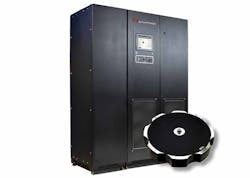How long do you need emergency power before your backup generators kick in? It’s a critical question for data centers, who rely on uninterruptible power supply systems (UPS) to keep their servers and storage online during utility power outages.
This “ride-through” power has been the central issue in a long-running industry debate about the merits of flywheel-based UPS systems, which typically provide 15 to 20 seconds of power at full load.
Active Power hopes to alter that debate. The flywheel UPS specialist today announced the CleanSource 275XT, which is designed to provide longer runtime than previous flywheels, in some cases up to a minute of emergency power. By boosting the ride-through time, Active Power hopes to address a larger market and shift the conversation to highlight other selling points of Its flywheel systems.
The Flywheel Alternative
A flywheel is a spinning cylinder which generates power from kinetic energy, and continues to spin when grid power is interrupted. Although a flywheel offers a shorter ride-through time (about 15 to 20 seconds), it eliminates the need to replace batteries and requires less space. Many data center managers are wary of the short duration of flywheel power, preferring the longer window provided by battery UPS systems, just in case there are any delays starting the generators.
The CleanSource 275XT (extended runtime) UPS provides 25 seconds of runtime at full load, versus 15 seconds for earlier Active Power products. The company says the runtime can be as long as a minute for customers with 40 to 50 percent loads, which is typical of many mission-critical facilities. The previous runtime for these lower loads was about 28 to 30 seconds, Active Power says.
“We’ve had many requests for this from customers,” said Anderson Hungria, senior product manager for UPS at Active Power. “A lot of end users are looking for a little more runtime margin. We’ve seen some specs from a lot of customers for (backup time of) a minute. Our goal is to go back to these customers that previously rejected us on runtime, and start new conversations.”[clickToTweet tweet=”Anderson Hungria: A lot of end users are looking for a little more UPS runtime margin.” quote=”Anderson Hungria: A lot of end users are looking for a little more UPS runtime margin.”]
There are two ways to generate longer runtime with a flywheel UPS – spinning the flywheel faster, or making it bigger. The CleanSource 275XT spins at 10,000 rotations per minute, or about 30 percent faster than previous UPS systems.
To accomplish this, Active Power made some updates to the ball bearings, which can support a higher pulse to drive a faster spin, while retaining the same temperature limits and same lifespan of about four years. Some additional components of the UPS have also been refined to accommodate higher wheel speed.
One Minute A Key Benchmark?
The new system can support up to 275 KVA of power. Many large data centers use higher capacity UPS systems supporting 750 kW to one megawatt at a time.
“We know most customers are deploying more than 300 kVA,” said Todd Kiehn, Vice President of Marketing and Modular Infrastructure Solutions, who said Active Power will introduce extended runtime UPS systems at higher capacities in 2017. In the meantime, the modular design will allow users to run multiple systems in parallel to support additional capacity.
The CleanSource 275XT will be about the same price as the company’s existing Clean Source 300 offering, Hungria said, while offering the same look and feel of current Active Power units.
Kiehn says the extended backup window creates a meaningful expansion of the market for flywheel UPS.
“We’ve been tracking this for a long time,” said Kiehn. “About a quarter of our customers are asking for less than a minute. We think providing an extra 15 to 30 seconds will help, especially with the psychological and emotional factors (in evaluating runtime).
“About half of our installed base is mission-critical but not data center,” said Kiehn, who cited hospitals as a target customer segment, as they need reliable UPS backup but also have limited space.
Hyperscale Seen As Growth Area
“On the data center side, interest started with the hyperscale and web scale companies, who have been engineering their facilities to take out cost and footprint,”said Kiehn. “As that has become more visible through initiative like the Open Compute project, we’ve seen this interest trickle down to enterprise companies and some colocation providers.”
It’s not Active Power’s first effort to address customer concerns about ride-through time. In 2012, Active Power introduced a UPS with hybrid capabilities, allowing users to augment the flywheel with batteries to extend the ride-through time.
“With the CleanSource 275XT, Active Power sets the standard for the longest runtime UPS with permanent energy storage flywheel that we see in the market today,” said Mark A. Ascolese, president and CEO, for Active Power
CleanSource 275XT will be available for shipment to customers worldwide in the fourth quarter 2016. Additional configurations and options will be available in the first half of 2017.
About the Author


